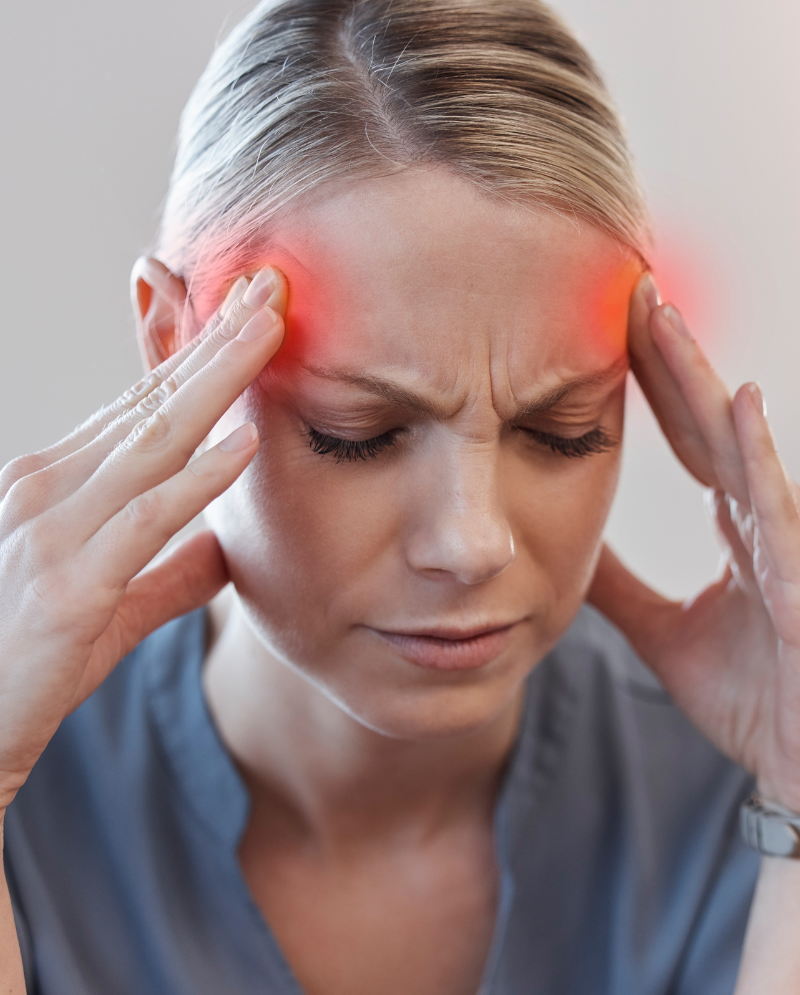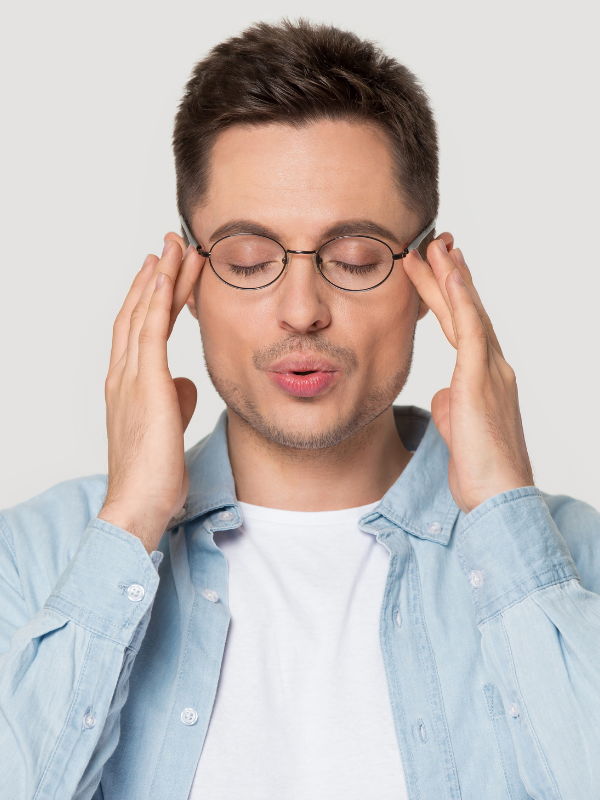Headaches
Relief Is A Call Away!
Very few people avoid ever getting a headache, and they appear in many different ways. They may affect the whole head or just a part. They may be felt as anything from a dull ache to a sharp stabbing. They can last a few minutes or a few days. Some people feel nauseous, and others don’t. Rarely do they indicate anything serious, but some require urgent medical attention.
There are many reasons for headaches, including drug reactions, temporomandibular joint dysfunction (TMJ), tight neck muscles, low blood sugar, high blood pressure, stress, and fatigue, but most can fit into one of two categories: tension (cervicogenic) headaches and migraine headaches. A third less common category is cluster headaches, which are similar to migraines.
Tension Headaches
Tension headaches are the most prevalent form of headache, impacting about 75% of those who experience headaches. Typically, these headaches manifest as a persistent, dull ache that can affect one or both sides of the head. Many describe the sensation as wearing a tight band around their head or around their eyes. These headaches generally develop gradually, often in the afternoon or as the day progresses, and can persist from a few minutes to several days and sometimes even months. While the pain might be intense, tension headaches usually don’t accompany other symptoms like nausea or vomiting.
Primary Factor: Stress
Stress is a primary trigger for tension headaches. Factors such as poor posture can stress the spine and the muscles in the upper back and neck, leading to these headaches. Specifically, tension headaches are often caused by subluxations—misalignments of the vertebrae—in the upper neck, along with active trigger points. When stress affects the upper cervical vertebrae, altering their normal movement or position, it can cause the rectus capitis posterior minor (RCPM) muscle to spasm. This small muscle connects to the dura mater—the pain-sensitive covering of the brain—through a tendon that runs between the upper neck and the skull base. While the brain itself does not feel pain, pulling on the dura mater by the RCPM can result in significant headache pain.
Additionally, referred pain from trigger points in the muscles, such as the sternocleidomastoid (SCM) or levator, located along the side of the neck, can also lead to tension headaches. This is particularly common in individuals who have experienced a whiplash injury, further complicating the pain experience.
Migraine Headaches
Around 25 million people in the U.S. experience migraine headaches a year, 75% of whom are women. Migraines are characterized by intense pain and throbbing, often coupled with nausea and sensitivity to light or noise. Their duration may be a few hours to several days, and there is sometimes a precursory visual symptom known as an “aura” that alerts the sufferer to the coming attack. This aura may be experienced as flashing lights or a dream-like appearance to the world.
Migraines tend to run in families, and sufferers usually have their first attack before they reach 30 years old. Apart from this, the experience varies, with some people having several attacks every month and others perhaps once a year. They may also become more or less severe as the sufferer gets older.
The process of a migraine headache is that the blood vessels in the brain first constrict and then dilate. The constriction decreases the blood flow, causing the visual symptoms many people experience. Even if an aura does not occur, most sufferers know when a migraine is nearing. When the blood vessels then dilate, the rapid increase in blood pressure leads to a pounding headache, which thumps in time to the heartbeat.
The exact reason the blood vessels constrict is not fully understood, although several common triggers have been identified. These include lack of sleep, stress, flickering lights, strong smells, a change of weather, and certain foods – the chief culprit being the amino acid tyramine.
Cluster Headaches
Cluster headaches are typically felt on one side of the head behind the eyes, and this is the only headache that usually occurs at night. They don’t typically last long, but they are excruciating. Around 1 million people in the United States suffer this type of headache, and, unlike migraines, more men than women are affected. They have termed cluster headaches as they tend to hit up to four times a day over several days. The good news is that another bout may not occur again for months or years. Cluster headaches are similar to migraines in that they are likely caused by a dilation of the blood vessels in the brain.
Treatment for Headaches
Many research studies have shown chiropractic adjustments to be very effective at treating tension headaches, especially those that stem from the neck. For example, a 2001 report by researchers at the Duke University Evidence-Based Practice Center in Durham, NC, found that chiropractic manipulation provided almost immediate improvement, with far fewer side effects and more long-lasting relief than prescription medications. Another study found that just four weeks of chiropractic treatment was enough to provide a sustained benefit far outweighed any pain medication delivered.
Each case is different and must be individually evaluated before chiropractic care can be delivered. However, manipulating the upper two cervical vertebrae and the vertebrae at the junction of the cervical and thoracic spine significantly improves most cases.
Trigger Points
The main muscles that hoard trigger points for headaches are the splenius muscles, the suboccipitals, the sternocleidomastoid (SCM), and the trapezius. The splenius muscles comprise two individual muscles – the splenius capitis and the splenius cervicis. The splenius capitis runs to the base of the skull, and the splenius cervicis runs to the upper cervical vertebrae. Trigger points in these muscles often cause pain from the head to the back of the eye and on the top of the head.
The suboccipitals consist of four small muscles that maintain proper movement and positioning between the first cervical vertebra and the base of the skull. Trigger points here cause pain inside the head from the back of the skull to the eye and forehead. As a result, the whole side of the head can hurt, much like the pain of a migraine.
The sternocleidomastoid (SCM) muscle runs from the base of the skull, behind the ear, down around the side of the neck, and attaches to the top of the sternum. SCM trigger points can cause widespread problems, including dizziness, nausea, poor balance, and visual disturbances. Pain is most often in the eyes, over the eyes, and sometimes felt as an earache.
The trapezius muscle is a large, flat muscle that extends from the mid to upper back. One particular trigger point is located at the very top of the muscle, at the temple, and at the back of the head, often causing headaches. It may also create satellite trigger points in the temple or jaw muscles, leading to jaw or tooth pain.
Avoiding Headache Triggers
We all know that emotional stress – depression, anxiety, frustration, disappointment – can trigger headaches. Still, other causes exist, such as certain foods, odors, menstrual periods, weather changes, and air pressure. Even pleasant excitement can be a trigger for some people.
If headaches are a regular feature in your life, keeping a headache diary is a good idea to determine which factors may be responsible.
Food triggers include those that contain nitrite compounds, which dilate blood vessels and can result in a dull, pounding headache and sometimes a flushed face. Nitrite is found in products like heart medicine but is also used as a preservative in meat. Therefore, sodium nitrite in hot dogs and other processed meats should be avoided.
The amino acid tyramine should also be avoided. Foods such as ripe cheeses (cheddar, brie), soy sauce, chocolate, and any pickled or fermented food contain tyramine.
Monosodium glutamate (MSG) is another culprit used in soy sauce, as a meat tenderizer, and in many packaged foods as a flavor enhancer. Some common household chemicals, such as insecticides and cleaning products (carbon tetrachloride, especially), are problematic. Lead can also cause headaches, so avoid lead-based paints, batteries, and lead-glazed pottery.
Ready To Get Started?
Begin by filling out your forms and scheduling an appointment!
What People Say About Us.



